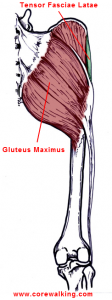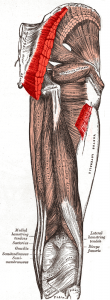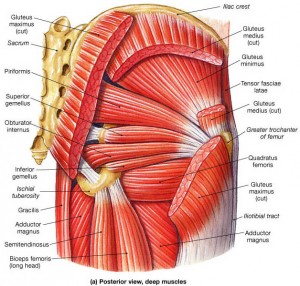 The gluteus maximus muscle is a uniquely human muscle and we are a tight assed species who need to learn to relax our butts.
The gluteus maximus muscle is a uniquely human muscle and we are a tight assed species who need to learn to relax our butts.
We are meant to have a butt—a nice round bubble of a butt.
If you have pets, take a look at their backside and notice that they don’t have a caboose quite like ours.
Chronically gripping and tightening is the default function of the gluteus maximus.
In the next few paragraphs, I’ll lay out how this ridiculously important muscle is supposed to function.
But bear in mind that precious few people actually use their butt as it was meant to be used.
The big gluteus maximus muscle was born when, along with the hamstrings, it extended down to pull the spine up on top of the pelvis bringing us to stand.
It grew in size and strength when it became a player on the team of muscles asked to help stabilize the trunk over the pelvis in an upright posture.
All three gluteal muscles –minimus, medius, and maximus— exist in four-legged animals and gluteus medius and minimus function similarly in humans and other quadrupeds.
These muscles serve to assist in internal and external rotation.
The most surface of the gluteals, gluteus maximus, took on a very different role when we came to stand.
The gluteus maximus muscle is attached at the ilium of the pelvis as well as the bottom of the back of the sacrum and the side of the coccyx (tail bone).
It is also tied into the thoracolumbar fascia which connects it to the erector spinea and sacrotuberous ligament.
The lower portion of the gluteus maximus has two heads, connecting into the IT Band and onto the femur bone.
The gluteus maximus has a quadrilateral shape and I have written before about quadrilaterally shaped muscles being stabilizers.
I consistently find that these quadrilateral stabilizers- quadratus lumborum, quadratus femoris, gluteus maximus—tend to be extremely tight due to poor posture that prevents them from actually working as designed.
The gluteus maximus has a number of functions. Acting on the leg it extends the femur, in connection with the IT Band it tenses the fascia lata and stabilizes the leg and shin when standing.
The upper half of the muscle abducts and internally rotates the hip joints while the lower half adducts and externally rotates the leg.
But far and away the most important thing that our gluteus maximus needs to do is stop working overtime.
If you tuck your pelvis or your thighs sink forward, I can guarantee you that your butt will be turned on and working more than it should as long as you are standing walking, and running. Sitting is a whole other story.
As soon as you finish reading this, stand up and feel what your gluteus maximus muscle is doing.
If it is working try to let it go or shut it off.
Then spend the next week noticing what your gluteus maximus, our glorious, uniquely human butt is doing. If it is working overtime try to give your butt some time off.



